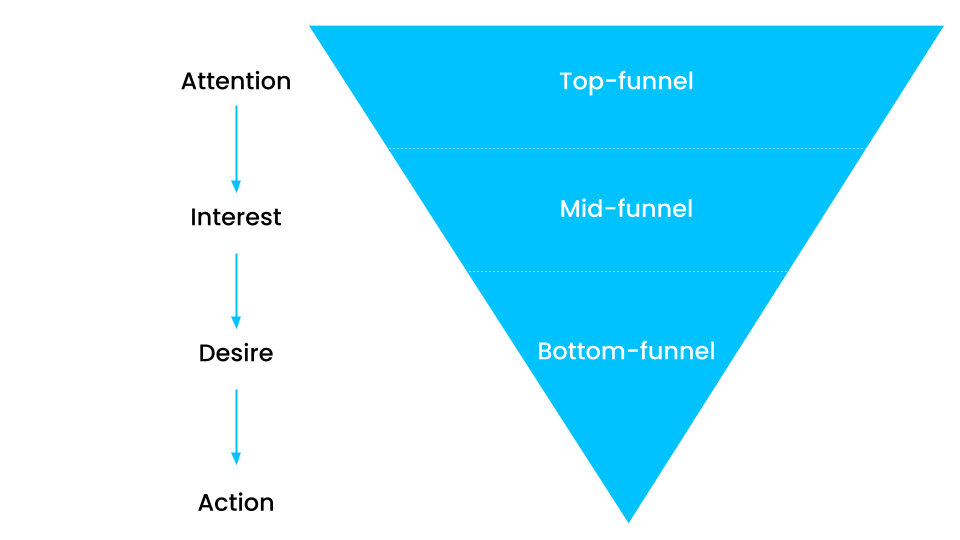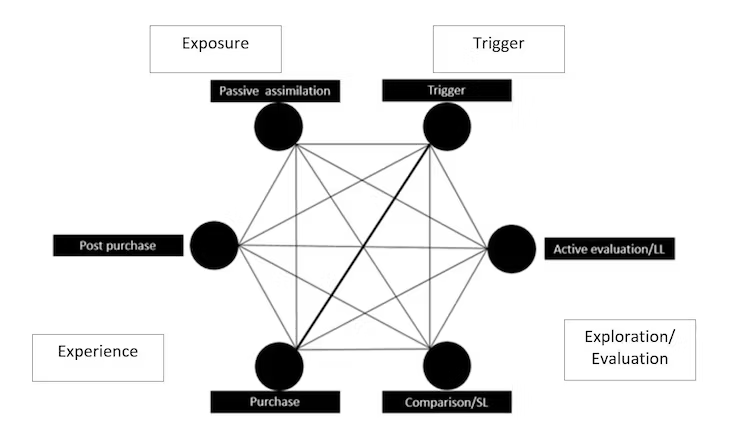/
Strategi
/
0 min read
What is a marketing funnel and why should you work with your funnel?

- What is a marketing funnel?
A marketing funnel, or a purchase funnel, visually represents users' purchasing journey. The stages are typically divided into top-funnel, mid-funnel, and bottom-funnel.
- What are the stages of a marketing funnel?
The stages of a marketing funnel are attention, interest, desire, and action (AIDA), or alternatively top-funnel, mid-funnel, and bottom-funnel. These represent different phases of the users' purchasing journey.
- What is the AIDA model?
The AIDA marketing model represents purchasing journeys with the stages of Attention, Interest, Desire, and Action to guide users from discovery to purchase.
Us marketers often throw around buzzwords such as marketing funnel, conversions, touchpoints, and others. We rarely take the time to explain what we actually mean by them. Now, I am taking the time to explain the marketing funnel.
A marketing funnel is a visual representation of the user's purchasing journey. Customer journeys are incredibly complex, and they have become even more so as the share of internet purchases has increased.
By the end of this blog post, you will understand different approaches to tackling purchasing journies and how marketing funnels have evolved over the years.
The traditional understanding of the customer journey: AIDA
Are you familiar with the AIDA model?
The model has been the foundation of what is today known as the marketing funnel. It dates back to 1898 when Edward K. Strong described the various stages in a purchasing journey.
Attention = The user becomes aware of your product or the problem it solves
Interest = The user expresses or experiences interest in your product
Desire = The user considers your product
Action = The user purchases your product: The user converts
The AIDA model has since been reformulated into what we in the marketing world call the funnel. The AIDA model is reformulated into the top, middle, and bottom stages. Most commonly used are the English terms: top-funnel, mid-funnel, and bottom-funnel.
How do you create content and marketing activities for the different stages?
You need to identify challenges or barriers at each part of your funnel. If people are unaware of your company, you need to make some noise. Conversely, if many know you and visit your website but don't convert, you need to work on your offering and your website's content.
Top-funnel (ToFu)
This corresponds to attention; at this stage, you need to create awareness for your company, product, or the problem you solve. This can be done in many ways. Typical methods are PR, push advertising on meta-networks (paid social), blog posts (SEO), TV commercials, etc.
Mid-funnel (MoFu)
The middle-funnel is where the customer is interested in your product or service. Now, you need to start lead nurturing, building authority, and building trust among your customers. Lead nurturing is particularly effective through email marketing and remarketing on paid channels. SEO also plays a vital role in addressing a customer's barriers or questions before considering an actual purchase.
Bottom-funnel (BoFu)
When customers are at the bottom of the funnel, they are ready to purchase. Now, your job is to convince your customers to buy from you. This can be effectively done using social proof, personalized emails, limited time offers to create a sense of urgency; not to forget SEO - you should be the one addressing the final questions on the user journey.

The correlation between the AIDA-model and the the marketing funnel
From a visual perspective, you can imagine a user entering at the top of the funnel and then going through different phases, with some customers being filtered out at each step down the funnel. Those who end up at the bottom of the funnel and choose to convert (aka. make a purchase) will correspond to the Action in the AIDA model.
How do you work with retention after purchase?
When customers buy from you, they have developed a relationship with you and an attitude toward your brand. Like all other relationships in life, customer relationships are about maintenance - otherwise, the relationship and thus the customer's loyalty die.
You are interested in your customers having a positive perception of you because you are interested in repurchases, and even better if the customer recommends you to others. Suppose you have proactive customer service or stand out from the competitors by surprising the customer. In that case, there is a greater chance that your customers will tell their acquaintances about their experience.
But before you can think about word-of-mouth marketing, you need to get a handle on creating loyalty among your customers. There are many ways to do this. A classic example is the use of customer clubs, like Club Matas by Matas, which is Denmark's largest customer club. Matas uses retention tools such as community and personalization of offers.

Source: Matas
In the post-purchase experience, your job is to nurture the relationship and ensure the customer has a positive impression of you. Additionally, you need to know when the customer needs other complementary products after the purchase: when a customer buys a printer, you should offer them printer cartridges two months later. For this task, email marketing is your best friend.
Why should you work with your marketing funnel?
You should because it is precious to understand where you excel and where you falter.
If you have a high conversion rate on your website, you know you are good at moving your customers from Desire to Action. Now, you need to ensure that more customers get down to Desire. In other words, this is where you will get the most bang for your buck, as it might be the weakest link in your funnel.
Working with your funnel fundamentally aims to identify which activities will create the most value relative to input. Once you have an overview, finding the marketing tool to solve your marketing challenge becomes more manageable.
Digital marketing funnel vs. classic marketing funnel
To state the obvious, the traditional marketing funnel is a normative and overly simplified framework that cannot explain purchasing processes in, for example, both B2B SaaS and B2C e-commerce.
If you offer accounting systems for SMEs that require organizational restructuring before implementation, the purchasing process is rarely as linear as the AIDA model prescribes. In such a case, your purchasing process would be a pendulum swing between different touchpoints.
There are many different views on and visualizations of a user journey. One of my personal favorites is Hankins Hexagon.
Even for a senior marketing specialist, the hexagon might look messy. But it should underline the main point: user journeys are messy and often cannot be put into simple formulas.

Source: Marketing Week
The model illustrates a reality where omni-channel marketing, influenced by algorithms, gives you different impressions. The different impressions follow more than just the linear process that AIDA offers.
Example: After you have bought a bike on a webshop, you enter the webshop's email flow. You are now in post-purchase and moving to active evaluation as you receive an email on how to clean and maintain your bike’s chain. The email acts as a trigger for your next purchase of a cleaning brush for your bike chain.
The model is one of many noteworthy attempts to illustrate purchasing journeys today. The crucial message here is that the funnel mindset effectively communicates which marketing channel or activity should appeal to different phases of your marketing funnel. However, you should be careful about only considering your purchasing process as linear, as user journeys can vary enormously, whether you are B2B, B2C, heavily omni-channel driven, or something entirely different.
Where does the sales funnel fit into this conversation?
You can roughly follow this rule of thumb: the higher the price, the more personal selling. This is also why there is typically more direct sales involved in B2B.
Products for businesses are normally more expensive. The margin usually also justifies spending more time on the deal, not to mention that a more expensive purchase often requires more consideration and guidance, which is obtained in the sale. The same applies to house and car purchases for private individuals.
The marketing and sales funnels typically work together if your purchase requires sales. To stick with the AIDA terminology, your lead becomes a sales-qualified lead (also called SQL) as soon as the lead has indicated interest or desire. Thus, the lead transitions from your marketing funnel to your sales funnel when you deem spending time on the sale relevant.
Conclusion
Your marketing funnel is a handy tool for creating an overview of your marketing activities. Consider whether your activity is building more awareness (top funnel) or if your effort is increasing the number of purchasers (bottom funnel). Optimizations will require different actions depending on where your business stands.
However, be cautious about clinging to normative views on how your marketing should function. The more channels you have in play, the harder it is to track what has led to a conversion. Therefore, you can advantageously view your user journey as a series of touchpoints that have other purposes than just leading your user linearly through the funnel.
The user journey is more complex, especially if you work with high-consideration purchases - or B2B marketing; this will force you to work more with the interplay between your marketing and sales funnel.
Marketing funnel FAQ
Below, I'll answer the most asked questions about marketing funnels.

Let us show you an SEO strategy that can take you to the next level
A brief meeting, where we review your position in the market and present the opportunities.
Let us show you an SEO strategy that can take you to the next level
A brief meeting, where we review your position in the market and present the opportunities.